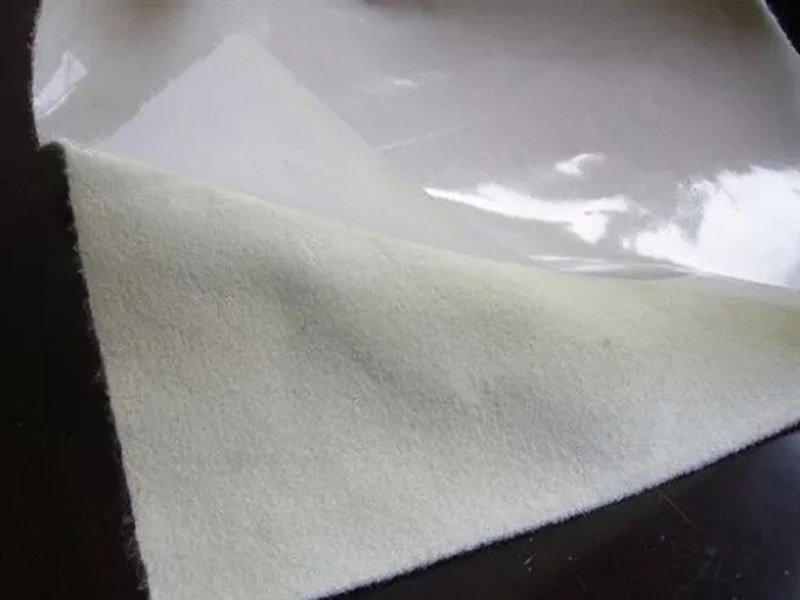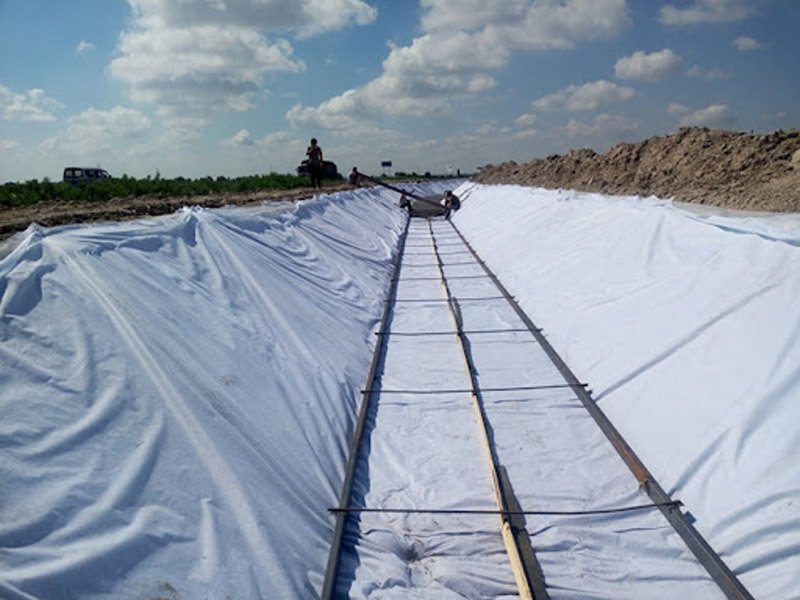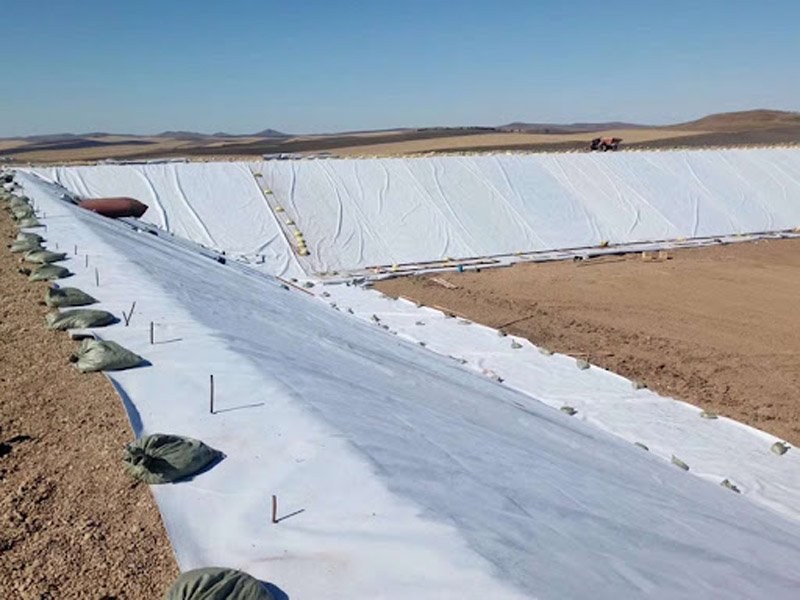The geomembrane component of composite geomembranes is usually made of materials like high-density polyethylene (HDPE), low-density polyethylene (LDPE), or polyvinyl chloride (PVC). It acts as the primary impermeable layer, providing resistance against the passage of liquids or gases.The specific design and composition of composite geomembranes can vary depending on the application and project requirements. Factors such as the type of geomembrane material, the number and type of geotextile layers, and the bonding methods used between the layers can influence the overall performance of the composite geomembrane.
BPM Geosynthetics manufactures and offers high-quality composite geomembranes with custom size and thickness in bulk order at competitive factory prices. We’ll explore composite geomembranes properties, applications, and their future.
1. What Is Composite Geomembrane?
Composite geomembranes refer to a type of geosynthetic material that combines different layers or components to provide enhanced performance and functionality. They typically consist of a geomembrane, which is a continuous impermeable barrier, and one or more geotextile layers.The impermeable membrane layer acts as a barrier, preventing the passage of liquids or gases. It provides excellent containment properties and is resistant to chemical degradation. The geotextile layers, on the other hand, serve various functions depending on the specific application. They can provide mechanical reinforcement, protect the impermeable layer from punctures or UV degradation, and act as a filter to allow water to pass through while retaining soil particles.
The geotextile layers in composite geomembranes serve several purposes. They can act as a protective layer for the geomembrane, providing mechanical reinforcement and preventing damage during installation or long-term use. Geotextiles can also enhance the composite geomembrane’s filtration capabilities, allowing water to pass through while retaining fine particles.


2. What is Importance Of Choosing Best Composite Geomembrane?
Choosing the best composite geomembrane is of utmost importance in environmental containment applications. Here are the key reasons why selecting the right composite geomembrane is crucial:
2.1 Effective Containment
The primary objective of a composite geomembrane is to ensure efficient containment, preventing the migration of liquids, gases, or contaminants. Opting for a top-quality composite geomembrane guarantees a highly impermeable and chemically resistant barrier layer, minimizing the risk of leaks or contamination.
2.2 Durability and Longevity
Environmental containment systems often face harsh conditions, including UV exposure, temperature fluctuations, and mechanical stresses. Opting for a durable and long-lasting composite geomembrane helps maintain the integrity and longevity of the containment system, reducing the need for frequent repairs or replacements.
2.3 Compatibility with Site Conditions
Each environmental containment project possesses unique site conditions, such as soil types, groundwater levels, and chemical exposures. Selecting a composite geomembrane that is compatible with the specific site conditions enhances its performance and resistance to potential challenges, such as punctures, chemical degradation, or differential settlement.
2.4 Robust Mechanical Properties
Composite geomembranes with reinforced geotextile layers exhibit enhanced mechanical properties, including tear resistance, puncture resistance, and tensile strength. These properties are crucial for withstanding installation stresses, maintaining integrity during the service life, and resisting damage caused by external forces.
2.5 Filtration and Drainage Performance
Certain applications necessitate composite geomembranes with specific filtration or drainage capabilities. Carefully selecting geotextile layers within the composite geomembrane ensures efficient filtration of water or gases while preventing clogging or migration of soil particles, contributing to the overall effectiveness of the containment system.
2.6 Compliance with Regulations
Environmental containment projects are often subject to regulatory requirements and standards. Choosing a composite geomembrane that meets or exceeds these standards ensures compliance and helps avoid potential legal or environmental issues.
3. What Is Application Of Composite Geomembrane?
Composite geomembranes have a wide range of applications in environmental containment and geotechnical engineering. Some key applications of composite geomembranes include:
3.1 Landfills
Composite geomembranes are commonly used as liners and caps in landfill systems to prevent the migration of leachate (liquid waste) into the surrounding soil and groundwater. They provide an impermeable barrier that ensures proper containment and environmental protection.
3.2 Mining
Composite geomembranes are utilized in heap leach pads, tailings storage facilities, and other containment structures. They prevent the seepage of chemicals, acids, or leachate from mining activities, safeguarding the environment and surrounding ecosystems.
3.3 Pond and Reservoir Liners
Composite geomembranes are employed in the construction of ponds, reservoirs, and water storage facilities. They create impermeable barriers that prevent water loss or seepage, ensuring efficient water management and conservation.
3.4 Secondary Containment
They are employed in secondary containment systems for storage tanks, pipelines, and industrial facilities. They act as a protective barrier, preventing leaks or spills from reaching the surrounding environment.
3.5 Environmental Remediation
They are used in environmental remediation projects, such as the capping of contaminated soil or waste sites. They create a barrier that isolates and contains the hazardous materials, preventing further contamination and allowing for effective remediation.
3.6 Agriculture and Aquaculture
They are utilized in agricultural applications, such as lining irrigation canals, catchment ponds, and agricultural ponds. They prevent water seepage and improve water storage efficiency. In aquaculture, composite geomembranes are used in fish ponds and shrimp farms to maintain water levels and prevent seepage.


4. How To Choose Best Composite Geomembrane?
When choosing the best composite geomembrane for a specific application, several factors should be considered. Here are some key considerations:
4.1 Project Requirements
Understand the specific project requirements, including containment levels, site conditions, environmental regulations, and performance expectations. This knowledge will aid in choosing a composite geomembrane that aligns with the project’s objectives and specifications.
4.2 Material Selection
Evaluate the available geomembrane materials (e.g., HDPE, PVC) and their properties. Consider factors such as chemical resistance, UV stability, flexibility, and long-term durability. Opt for a material that suits the site conditions and anticipated exposure to chemicals, weather conditions, and potential risks.
4.3 Geotextile Properties
Assess the characteristics of the geotextile layers within the composite geomembrane. Consider factors such as mechanical strength, filtration capabilities, and compatibility with the geomembrane material. The geotextile layers should provide the necessary protection, reinforcement, and filtration performance based on the project’s requirements.
4.4 Thickness and Layer Configuration
Determine the appropriate thickness of the composite geomembrane and the arrangement of its layers. Thicker geomembranes offer increased puncture resistance and may be advantageous in high-stress applications. Consider the number and configuration of geotextile layers to optimize filtration, drainage, and mechanical properties.
4.5 Testing and Certification
Look for composite geomembranes that have undergone rigorous testing and certification by reputable organizations or comply with recognized industry standards. This ensures that the geomembrane has been thoroughly evaluated for performance, quality, and compliance with relevant regulations.
4.6 Technical Support
Assess the availability of technical support and expertise provided by the manufacturer or supplier. Ensure they can offer guidance on proper installation, compatibility with site conditions, and any specific project requirements.
4.7 Cost-Effectiveness
Consider the overall cost-effectiveness of the composite geomembrane. Evaluate not only the initial material cost but also its expected lifespan, maintenance requirements, and long-term performance. Investing slightly more in a superior composite geomembrane may result in significant cost savings over the project’s lifespan.
4.8 Manufacturer’s Reputation
Select a composite geomembrane from a reputable manufacturer with a proven track record of delivering high-quality products. Research the manufacturer’s reputation, experience, and customer reviews to assess their reliability and the quality of their geomembranes.
5. Conclusion
By carefully considering these factors, it is possible to select the best composite geomembrane that meets the project’s performance, durability, and compliance needs. Seeking advice from industry experts or geosynthetic specialists can also provide valuable insights and assistance in making an informed decision.
BPM GEOSYNTHETICS is a leading manufacturer of geomembranes, geotextiles and other geotechnical materials. If you have any questions, please feel free to contact us.





